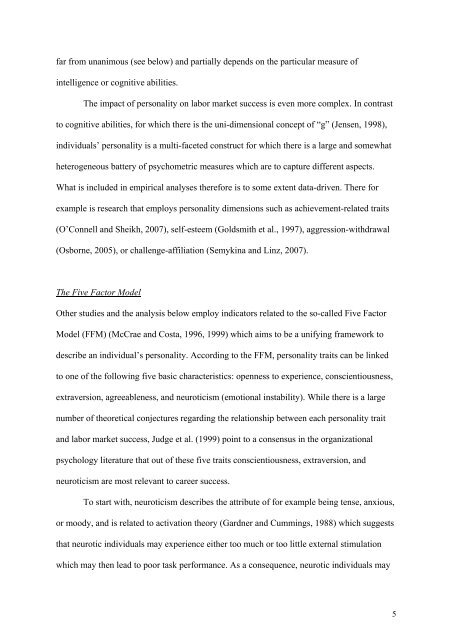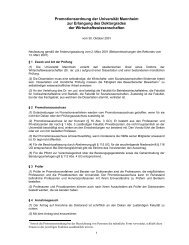The returns to cognitive and non-cognitive abilities in Germany
The returns to cognitive and non-cognitive abilities in Germany
The returns to cognitive and non-cognitive abilities in Germany
You also want an ePaper? Increase the reach of your titles
YUMPU automatically turns print PDFs into web optimized ePapers that Google loves.
far from unanimous (see below) <strong>and</strong> partially depends on the particular measure of<br />
<strong>in</strong>telligence or <strong>cognitive</strong> <strong>abilities</strong>.<br />
<strong>The</strong> impact of personality on labor market success is even more complex. In contrast<br />
<strong>to</strong> <strong>cognitive</strong> <strong>abilities</strong>, for which there is the uni-dimensional concept of “g” (Jensen, 1998),<br />
<strong>in</strong>dividuals’ personality is a multi-faceted construct for which there is a large <strong>and</strong> somewhat<br />
heterogeneous battery of psychometric measures which are <strong>to</strong> capture different aspects.<br />
What is <strong>in</strong>cluded <strong>in</strong> empirical analyses therefore is <strong>to</strong> some extent data-driven. <strong>The</strong>re for<br />
example is research that employs personality dimensions such as achievement-related traits<br />
(O’Connell <strong>and</strong> Sheikh, 2007), self-esteem (Goldsmith et al., 1997), aggression-withdrawal<br />
(Osborne, 2005), or challenge-affiliation (Semyk<strong>in</strong>a <strong>and</strong> L<strong>in</strong>z, 2007).<br />
<strong>The</strong> Five Fac<strong>to</strong>r Model<br />
Other studies <strong>and</strong> the analysis below employ <strong>in</strong>dica<strong>to</strong>rs related <strong>to</strong> the so-called Five Fac<strong>to</strong>r<br />
Model (FFM) (McCrae <strong>and</strong> Costa, 1996, 1999) which aims <strong>to</strong> be a unify<strong>in</strong>g framework <strong>to</strong><br />
describe an <strong>in</strong>dividual’s personality. Accord<strong>in</strong>g <strong>to</strong> the FFM, personality traits can be l<strong>in</strong>ked<br />
<strong>to</strong> one of the follow<strong>in</strong>g five basic characteristics: openness <strong>to</strong> experience, conscientiousness,<br />
extraversion, agreeableness, <strong>and</strong> neuroticism (emotional <strong>in</strong>stability). While there is a large<br />
number of theoretical conjectures regard<strong>in</strong>g the relationship between each personality trait<br />
<strong>and</strong> labor market success, Judge et al. (1999) po<strong>in</strong>t <strong>to</strong> a consensus <strong>in</strong> the organizational<br />
psychology literature that out of these five traits conscientiousness, extraversion, <strong>and</strong><br />
neuroticism are most relevant <strong>to</strong> career success.<br />
To start with, neuroticism describes the attribute of for example be<strong>in</strong>g tense, anxious,<br />
or moody, <strong>and</strong> is related <strong>to</strong> activation theory (Gardner <strong>and</strong> Cumm<strong>in</strong>gs, 1988) which suggests<br />
that neurotic <strong>in</strong>dividuals may experience either <strong>to</strong>o much or <strong>to</strong>o little external stimulation<br />
which may then lead <strong>to</strong> poor task performance. As a consequence, neurotic <strong>in</strong>dividuals may<br />
5















